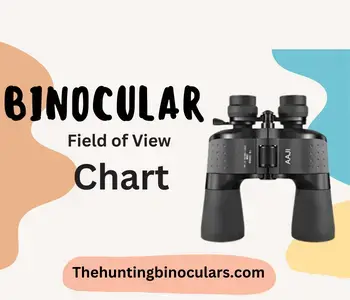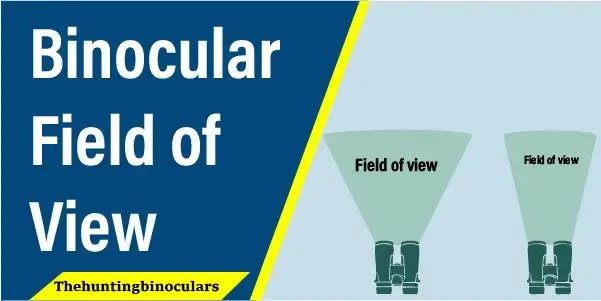
A binocular field of view chart is a way to compare the magnification capabilities of binoculars. The binocular field of view is the angular distance from the front of a binocular lens to its back. It helps determine what we can see with a certain pair of binoculars. Degrees are usually used to express the field of view.
It is an important factor in the design of binoculars because it determines, to a large extent, the field of view that the observer sees through the optics. The distance between the binoculars the size of the objective lenses and the magnification of each lens must be known to specify the FOV (Field of View) correctly.
It’s important to know the field of view of a particular binocular before you buy it. The field of view relates to the number of objects you can see with the binoculars in the given time frame. It’s important to have a good field of view for binoculars because you will see a greater number of objects to help you make a better decision. This blog will explain the field of view and offer a chart with information on the field of view of different types of binoculars.
Table of Contents
Binocular Field of View Chart An Informative Post
What is a Good Field of View for Binoculars
What does a field of view mean? The field of view is the area of the sky you can see at a single time when looking through a pair of binoculars. There is no angle associated with this term. A good field of view is large enough to see what’s happening.
However, there are more factors to consider. When viewing from 1,000 yards, binoculars have an ideal field of view of 300 to 375 feet. When viewed through binocular lenses, a field of view is the area of the sky that can be seen.
The field of view is determined by the size of your opening and the binoculars’ magnification. Most fields of view are between 90 and 110 degrees; with higher magnification, binoculars’ field of view can be 130 degrees. The field of view of 8x embellishments is generally 90 degrees.
When choosing binoculars, the field of view is the most important factor to consider. It means that you will be able to spot an animal without scanning or moving your binoculars.
A wide field of view binoculars has a smaller magnification range. That means that your binoculars will have higher light-gathering ability and a wider field of view.
Using binoculars, you can view a specific field of view. At the widest point, it will be about 180°. Through a pair of binoculars, you see an image of that size. The magnification range is the range of the magnification. The higher the magnification range, the more you will see.
The visual acuity or resolution is the image quality that you see through your binoculars. It is determined by the number of pixels in the quality of the lens. A higher resolution means you will see a finer image with more detail.

What is the Most Common Size of a Binocular Field of View
When choosing a pair of binoculars, it is important to determine the magnification of your binoculars. Magnification is the ratio of the size of the image to the size of the field of view of the person looking through the binoculars. This is referred to as the field of view expressed in degrees.
The field of view of binoculars is typically between 50 and 60 degrees. However, some binoculars have a field of view of up to 70 degrees.
The field of view is the area that the binoculars can see at one time. When the binoculars are set to the same magnification, the field of view is the same for both. However, sometimes the field of view can be affected by the size of the objective.
The objective is the lens that collects the light from the birds. The bigger the objective, the lighter it contains, and the smaller the objective, the less light it collects. This is why some birdwatchers choose a larger objective for landscapes and a smaller one for birds.
What Does the Binocular Field of View Chart Mean
If you have a pair of binoculars and want to see as much as possible, your field of view can help you. The field of view is the width of the area you can see, and it’s usually described in two ways: angular field of view and linear field of view. The angular field of view is the distance your binoculars can see in one direction and is usually measured in degrees.
The linear field of view is the distance your binoculars can see in a straight line in front of them, and it’s usually measured in meters.
A binocular field of view chart is a tool used to measure the angular field of view and linear field of view for binoculars. The angular field of view of a binocular is the angle the binoculars can see. The linear field of view of a binocular is the width of the binocular area.

FAQs | BINOCULAR FIELD OF VIEW CHART
How Do You Choose a Good Field of View Binoculars?
There are some key factors to consider when choosing a binocular. The field of view is the range of what the binoculars will show you. The key is to choose the binoculars to show you the area around you while staying comfortable to use. Some of the factors to consider are weight, magnification, and price.
What Do 30×60 Binoculars Mean?
A binocular field of view is the angle between the left and right eyes. The width of the field is measured in degrees and is determined by the width of the lenses. The lenses can be measured in millimeters. For example, a binocular with a field of view of 30 degrees has a width of 60 millimeters. 30×60 binoculars are a good size for birding and hunting.
Read more about What Does 20×50 Mean on Binoculars.
What is the Recommended Field of View for Binoculars?
The field of view is the distance your binoculars can see. The field of view is measured in feet. The recommended field of view for binoculars is between 6 and 12 feet.
What are the Types of Binoculars?
There are many binoculars to choose from, such as full-sized binoculars, compact binoculars, rifle scopes, and more. The most common type of binoculars is full-sized binoculars.
What are Binoculars For Stargazing?
Beginners often find that cheap binoculars – available in any discount store – can provide them with a satisfying stargazing experience. Magnification and light-gathering power in astronomy give you a better view of the heavens.
Conclusion
We hope you enjoyed our blog post about the Binocular field of view chart. We know that finding the right pair of binoculars is one of the most important decisions you’ll make for your next backpacking trip or hunting trip.
Our post will help you make that decision more easily so that you can enjoy your excursion! If you have any questions, make sure you contact us. Thank you for reading, and we hope to hear from you soon!
For Your Reading!

How much field of view is lost when using one eye too focus?
Example 130 metres for binoculars at 1000 meters distance
Against a monocular with the same field of view?